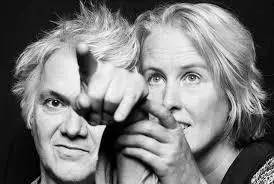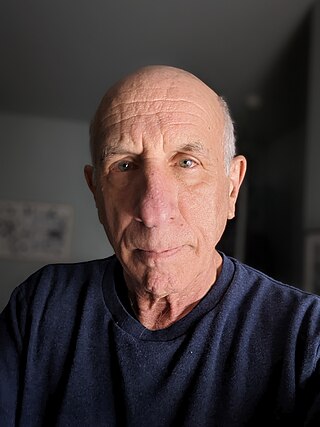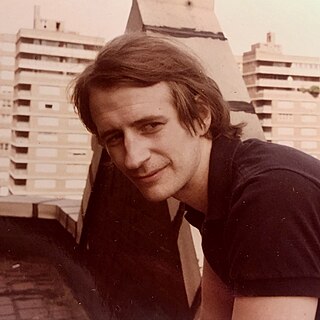Related Research Articles
Video art is an art form which relies on using video technology as a visual and audio medium. Video art emerged during the late 1960s as new consumer video technology such as video tape recorders became available outside corporate broadcasting. Video art can take many forms: recordings that are broadcast; installations viewed in galleries or museums; works streamed online, distributed as video tapes, or DVDs; and performances which may incorporate one or more television sets, video monitors, and projections, displaying live or recorded images and sounds.
Juan Downey was a Chilean artist who was a pioneer in the fields of video art and interactive art.

Jodi, is a collective of two internet artists, Joan Heemskerk and Dirk Paesmans, created in 1994. They were some of the first artists to create Web art and later started to create software art and artistic computer game modification. Their most well-known art piece is their website wwwwwwwww.jodi.org, which is a landscape of intricate designs made in basic HTML. JODI is represented by Upstream Gallery, Amsterdam.

Kenneth Feingold is a contemporary American artist based in New York City. He has been exhibiting his work in video, drawing, film, sculpture, photography, and installations since 1974. He has received a Guggenheim Fellowship (2004) and a Rockefeller Foundation Media Arts Fellowship (2003) and has taught at Princeton University and Cooper Union for the Advancement of Art and Science, among others. His works have been shown at the Museum of Modern Art, NY; Centre Georges Pompidou, Paris; Tate Liverpool, the Whitney Museum of American Art, New York, among others.

Shigeko Kubota was a Japanese video artist, sculptor and avant-garde performance artist, who mostly lived in New York City. She was one of the first artists to adopt the portable video camera Sony Portapak in 1970, likening it to a "new paintbrush." Kubota is known for constructing sculptural installations with a strong DIY aesthetic, which include sculptures with embedded monitors playing her original videos. She was a key member and influence on Fluxus, the international group of avant-garde artists centered on George Maciunas, having been involved with the group since witnessing John Cage perform in Tokyo in 1962 and subsequently moving to New York in 1964. She was closely associated with George Brecht, Jackson Mac Low, John Cage, Joe Jones, Nam June Paik, and Ay-O, among other members of Fluxus. Kubota was deemed "Vice Chairman" of the Fluxus Organization by Maciunas.
Tony Oursler is an American multimedia and installation artist married to Jacqueline Humphries. He completed a Bachelor of Fine Arts at the California Institute for the Arts, Valencia, California in 1979. His art covers a range of mediums, working with video, sculpture, installation, performance, and painting. The artist currently lives and works in New York City.
Peter Campus, often styled as peter campus, is an American artist and a pioneer of new media and video art, known for his interactive video installations, single-channel video works, and photography. His work is held in the collections of numerous public institutions, including The Museum of Modern Art, Whitney Museum of American Art, Solomon R. Guggenheim Museum, Hamburger Bahnhof - Museum für Gegenwart, Tate Modern, Museo Reina Sofía, Albright-Knox Art Gallery, Walker Art Center, and the Centre Georges Pompidou. The artist works on the south shore of Long Island.

Mary Lucier is an American visual artist and pioneer in video art. Concentrating primarily on video and installation since 1973, she has produced numerous multiple- and single-channel pieces that have had a significant impact on the medium.
Terry Alan Fox was an American Conceptual artist known for his work in performance art, video, and sound. He was of the first generation conceptual artists and he was a central participant in the West Coast performance art, video and Conceptual Art movements of the late 1960s and early 1970s. Fox was active in San Francisco and in Europe, living in Europe in the latter portion of his life.
Peggy Ahwesh is an American experimental filmmaker and video artist. She received her B.F.A. at Antioch College. A bricoleur who has created both narrative works and documentaries, some projects are scripted and others incorporate improvised performance. She makes use of sync sound, found footage, digital animation, and Pixelvision video. Her work is primarily an investigation of cultural identity and the role of the subject in various genres. Her interests include genre; women, sexuality and feminism; reenactment; and artists' books. Her works have been shown worldwide, including in San Francisco, New York, Barcelona, London, Toronto, Rotterdam, and Créteil, France. Starting in 1990, she has taught at Bard College as a Professor of Film and Electronic Arts. Her teaching interests include: experimental media, history of the non-fiction film, and women in film.
Peter d'Agostino is an artist and a professor of Film and Media Arts, Temple University, Philadelphia.

Dara Birnbaum is an American video and installation artist. Birnbaum entered the nascent field of video art in the mid-to-late 1970s challenging the gendered biases of the period and television’s ever-growing presence within the American household. Her oeuvre primarily addresses ideological and aesthetic features of mass media through the intersection of video art and television. She uses video to reconstruct television imagery using materials such as archetypal formats as quizzes, soap operas, and sports programmes. Her techniques involve the repetition of images and interruption of flow with text and music. She is also well known for forming part of the feminist art movement that emerged within video art in the mid-1970s. Birnbaum lives and works in New York.
Electronic Arts Intermix (EAI) is a nonprofit arts organization that is a resource for video and media art. An advocate of media art and artists since 1971, EAI's core program is the distribution and preservation of a collection of over 3,500 new and historical video works by artists. EAI has supported the creation, exhibition, distribution and preservation of video art, and more recently, digital art projects.
Phyllis Baldino is an American visual artist whose art engages in a conceptual practice that merges performance art, video art, sculpture, and installation in an exploration of human perception. Her single-channel videos are distributed by Electronic Arts Intermix in New York, NY. She currently lives and works in Brooklyn, New York.
Carole Ann Klonarides is an American curator, video artist, writer and art consultant that has been based in New York and Los Angeles. She has worked in curatorial positions at the Santa Monica Museum of Art (1997–2000) and Long Beach Museum of Art (1991–95), curated exhibitions and projects for PS1 and Museum of Modern Art (MOMA), Laforet Museum (Tokyo), and Video Data Bank, among others, and been a consultant at the Getty Research Institute. Klonarides emerged as an artist among the loosely defined Pictures Generation group circa 1980; her video work has been presented in numerous museum exhibitions, including "Video and Language: Video As Language", "documenta 8," "New Works for New Spaces: Into the Nineties,", and "The Pictures Generation, 1974-1984", and at institutions such as MoMA, the Smithsonian Hirshhorn Museum, Contemporary Arts Center, the New Museum, The Kitchen, and School of the Art Institute of Chicago (2016). Her work belongs to the permanent collections of MoMA, the Whitney Museum of American Art, Getty Museum, Centre Pompidou, Contemporary Arts Museum Houston, Museu-Fundacão Calouste Gulbenkian (Lisbon), Museo Nacional Centro de Arte Reina Sofía (Madrid), and National Gallery of Canada, and is distributed by the Video Data Bank and Electronic Arts Intermix (EAI).
Tony Labat is a Cuban-born American multimedia artist, installation artist, and professor. He has exhibited internationally, developing a body of work in performance, video, sculpture and installation. Labat's work has dealt with investigations of the body, popular culture, identity, urban relations, politics, and the media.

John Sanborn is a key member of the second wave of American video artists that includes Bill Viola, Gary Hill, Dara Birnbaum and Tony Oursler. Sanborn's body of work spans the early days of experimental video art in the 1970s through the heyday of MTV music/videos and interactive art to digital media art of today.
Shalom Gorewitz is an American visual artist. Gorewitz was among the first generation of artists who used early video technology as an expressive medium. Since the late 1960s, he has created videos that "transform recorded reality through an expressionistic manipulation of images and sound". His artworks often "confront the political conflicts, personal losses, and spiritual rituals of contemporary life". Gorewitz has also made documentary and narrative films.
Rita Myers is an American video installation artist. Her work is held in the collection of the Museum of Modern Art in New York.

Ed Bowes is a filmmaker, writer, and director who pioneered the use of video as cinema. The first person to make a feature-length film in video, he used poets, musicians, artists, video- and filmmakers as performers in films such as Romance (1975) and Better, Stronger (1978–79). As a result of the notice given to his camera work, Bowes began his long career as a cinematographer for filmmakers and video artists including Kathryn Bigelow, Lizzie Borden, Vito Acconci, and Robert Longo, among others. In the 1970s, he was instrumental in creating early exhibitions of video art at MoMA, The Kitchen, and other Downtown New York venues. He taught advanced filmmaking for more than three decades at the School of Visual Arts, where he influenced several generations of contemporary filmmakers. His work is in the collection of The Museum of Modern Art, New York, and Moderna Museet in Stockholm, Sweden. It is also represented in The Kitchen Archive at The Getty Research Institute and the Long Beach Museum of Art Video Archive.
References
- ↑ Gianelli, Ida; Beccaria, Marcella (2005). Video Art: The Castello di Rivoli Collection . Milan: Skira Editore. pp. 86. ISBN 978-8876245343.
- 1 2 Mondloch, Kate (2011). "The Matter of Illusionism: Michael Snow's screen/space". Screen/Space: The Projected Image in Contemporary Art. Manchester and New York: Manchester University Press. p. 88. ISBN 978-0719084638.
- ↑ Ross, David A. (2010). 100 Video Artists. Madrid: Exit. p. 14. ISBN 978-8493734701.
- ↑ "Electronic Arts Intermix - TV as a Creative Medium". www.eai.org. Retrieved 2017-01-11.
- ↑ Rush, Michael (2007). Video Art. New York: Thames & Hudson. pp. 19. ISBN 978-0-500-28487-2.
- 1 2 3 4 5 6 Meigh-Andrews, Chris (2006). "The Origins of Video Art". A History of Video Art: The Development of Form and Function. Oxford: Berg. pp. 61–3. ISBN 978-1845202194.
- ↑ "Frank Gillette - Official Catalogue Raisonne. Video Art". Frank Gillette - Official Catalogue Raisonne. Video Art. Retrieved 2017-01-17.
- 1 2 "Radical Software". www.radicalsoftware.org. Retrieved 2017-01-11.
- ↑ K. Horsfield and L. Hilderbrand (2006). Feedback. The Video Data Bank Catalog of Video Art and Artist Interviews. Philadelphia: Temple University Press. pp. 118. ISBN 9781592131822.
- ↑ Herzogenrath, Wulf; Edith, Decker (1989). Video-Skulptur retrospektiv und aktuell: 1963–1989. Koln: DuMont. p. 114. ISBN 978-3770123131.
- ↑ Meigh-Andrews, Chris (2011). "Video Installation in Europe and North America: The Expansion and Exploration of Electronic and Televisual Language 1969-89". Expanded Cinema: Art, Performance, Film. London: Tate Publishing. p. 127. ISBN 978-1854379740.
- ↑ "Electronic Arts Intermix: Hark! Hork!, Frank Gillette". www.eai.org. Retrieved 2017-01-17.
- ↑ Rosebush, Judson, ed. (1973). Frank Gillette - Video: Process and Meta-process. Syracuse, New York.: Everson Museum of Art. p. 12.
- ↑ "Tetragramaton | Video Data Bank". www.vdb.org. Retrieved 2017-01-17.
- ↑ "Muse | Video Data Bank". www.vdb.org. Retrieved 2017-01-17.
- ↑ "Electronic Arts Intermix: Quidditas, Frank Gillette". www.eai.org. Retrieved 2017-01-17.
- ↑ "Electronic Arts Intermix: Rituals for a Still Life, Frank Gillette". www.eai.org. Retrieved 2017-01-17.
- ↑ "Electronic Arts Intermix: The Maui Cycle, Frank Gillette". www.eai.org. Retrieved 2017-01-17.
- ↑ "Electronic Arts Intermix: Mecox, Frank Gillette". www.eai.org. Retrieved 2017-01-17.
- ↑ "Electronic Arts Intermix: Symptomatic Syntax, Frank Gillette". www.eai.org. Retrieved 2017-01-17.
- ↑ Roniger, Taney (2019-05-01). "Suzanne Anker & Frank Gillette: Strata". The Brooklyn Rail. Retrieved 2019-05-16.